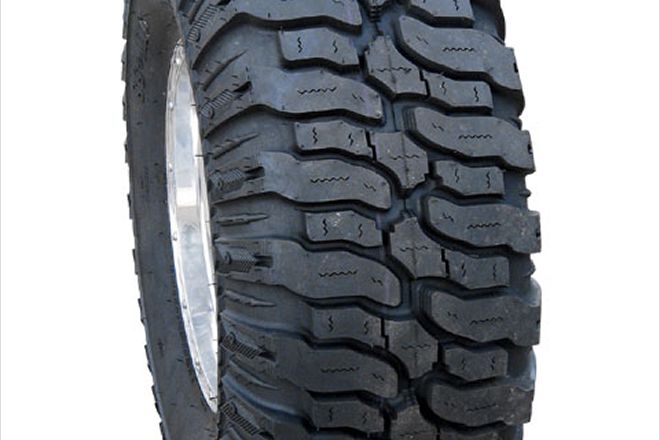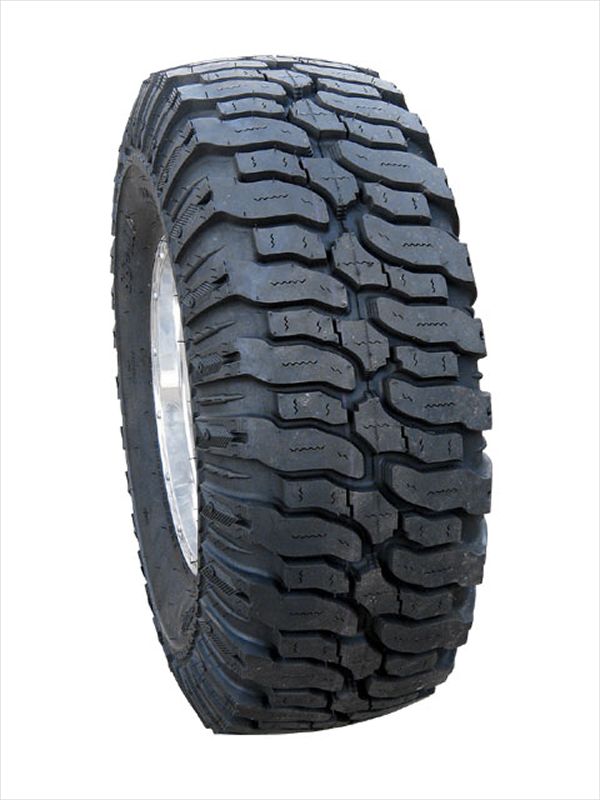

It doesn't require a degree in genealogy to see that this new tire is from Interco, the company that brought us the original Super Swamper TSL and the infamous Bogger. There's even a hint of the flowing lines of a TrXus STS in this design. And, as it turned out, there's a little of each of those tires' strengths and weaknesses in the SS- M16.
Look at the SS- M16 as a better Thornbird, if you will, which works on the trail yet is quite easy to live with on pavement-for a couple of reasons. For one, they're unusually round, so the ride was as smooth as the mere 0.013- inch average run-out observed on the Hunter GSP 9700 balancer had indicated. Also, the six tread plies absorb irregularities in the road surface very well, further enhancing the smooth ride quality.
A fair amount of howling was anticipated from the 10.1-inch-wide and aggressive tread, but the tire is actually nearly quiet up to about 35 mph, and after that audible but not loud. Until reaching speeds of 70 mph and above, at which point they're definitely loud. It's not howling but rather a growling noise-at least in our less-than-quiet test vehicle, which is also void of any insulation or other sound-deadening materials.
Having switched from a mild-treaded, overkill-stout tire to the two-ply sidewall M-16, it took a few miles to get used to the taller and softer sidewalls of the 33.8-inch tire, and initially we thought it was tracking. In reality, it was that the vehicle slithered (comparatively speaking) down the road with the smoother-riding tires, and steering response was slowed accordingly. Using a 16x8 wheel certainly didn't help, being on the narrow side for the 12-inch-wide 295/75 tire. After a few days of getting acquainted, everything felt fine again.
Aside from absorbing road irregularities, the tread also likes to absorb gravel in the 20/32-inch-deep voids between the large tread blocks, and this could be a concern with an everyday tire when combined with a dirt or gravel driveway. Once on pavement, and with the rocks flung out, those blocks are rolling far easier than we'd ever expected, and low rolling resistance is always a good thing. Especially if you value better mileage, from both the tires and the fuel tank.
Sharing some traits with the Thornbird, it wasn't too surprising to find that the large tread blocks also "rolled" somewhat freely on hard packed dirt-there just aren't enough biting edges to prevent losing traction in some situations, although there is a bit of siping in the large blocks, and that does help. Loose dirt allowed the lugs to dig in for a bite, and they did generally grip well on rocks. Not that the M-16 can grab small boulders like a Bogger does with its huge voids, but unlike a Bogger, the SS M-16's tread does flex quite well, which really helps in the traction department.
Borrowing a bit of the ability of the TrXus STS, the SS M-16 did surprisingly well in soft sand, especially considering that we never bothered to air down. Rather than sinking in, the tires did propel our overweight test machine forward, except when completely stabbing the throttle. Mud? Sorry, but we haven't a clue. Three years into a drought, and starting the test after the last meager drops had already fallen in SoCal, there was none to be had. Well, we actually do have a clue; better than a Thornbird or STS, but nowhere near as good a Bogger.
At this writing the SS- M16 is already available in 26 sizes, ranging from a 31x10.50R15 to a 40x14.50R24, so there should be a suitable size for you to try out. And knowing Interco, there will be more to follow.
Specifications
Tire: Interco SS- M16
Size: 295/75R16
Type: Radial
Load range: E
Max load (lb @ psi): 3970 @ 80
Sidewall: 2-ply Polyester
Tread: 2-ply Polyester, 2-ply steel, 2-ply nylon
Approved rim width (in): 7.5 - 9
Tread depth (in): 20/32
Tread width (in): 10.1
Section width (in): 12.0
Overall diameter (in): 33.8
Static loaded radius (in): N/A
Revs per mile: 657
Weight (lb): 75
Test vehicle: K5 Blazer, 6,300 lb